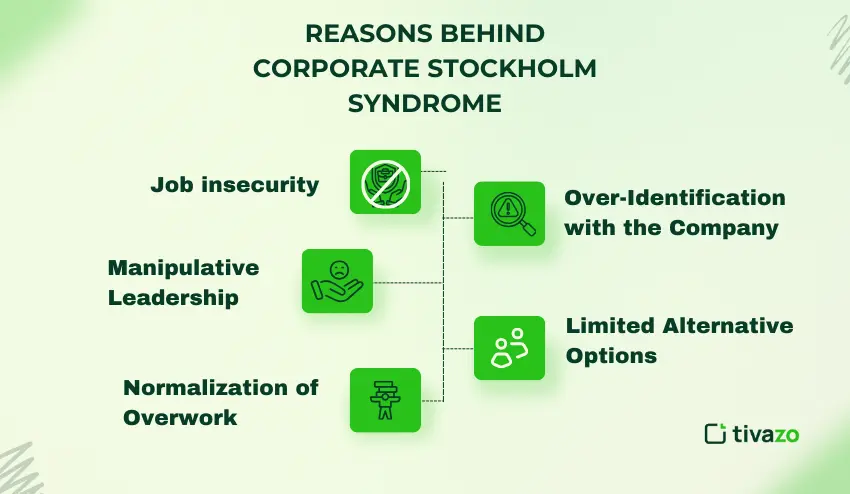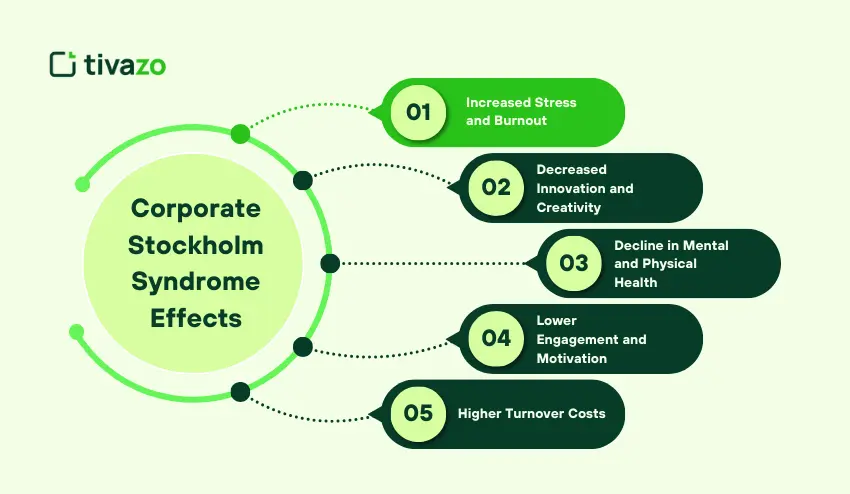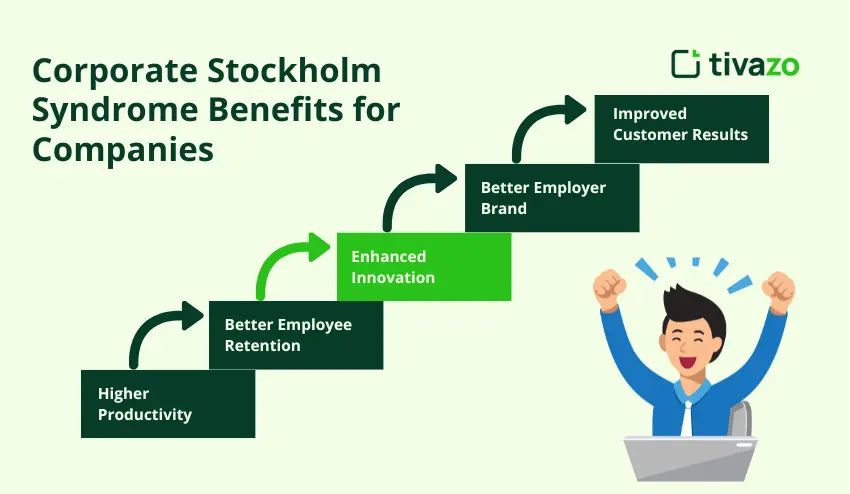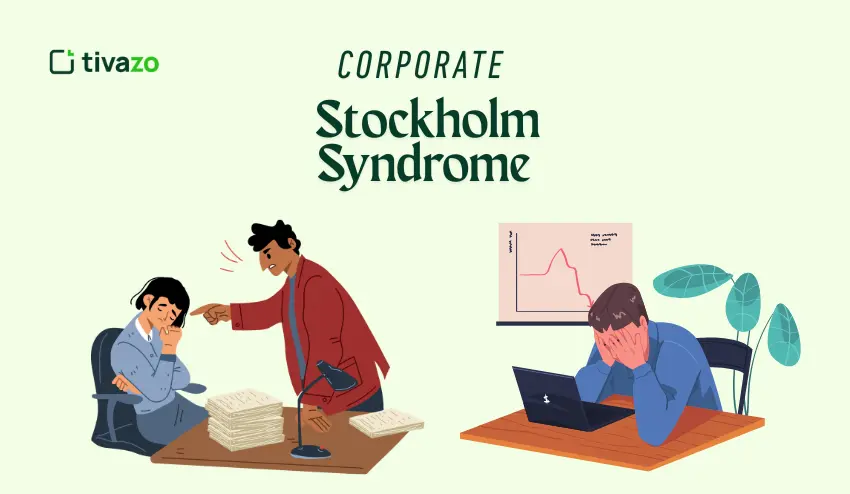Have you ever encountered an individual who justifies their boss even when all other people are aware that the boss is not fair? Or perhaps you see an employee who is working 70 hours a week, stressed out of his mind, yet still states that he is lucky to have this job.
This is not just loyalty; this is a symptom of Corporate Stockholm Syndrome.
It occurs when the workers remain committed to a firm that under-values or mistreats them. They justify overworking, poor remuneration, or an unhealthy environment at work due to the fear of losing their chance at security, prestige, or belonging. Gradually, they come to the point of believing that the needs of the company are more significant than their own good.
The result? Burnout, low productivity, and workplaces that continue to operate on fear rather than on motivation.
In this blog, we will explain what Corporate Stockholm Syndrome is, the reasons it occurs, the harm it causes both employees and the businesses, and what can be done to help break the cycle.
What is Corporate Stockholm Syndrome?
Corporate Stockholm Syndrome is a workplace phenomenon in which employees will become loyal or attached to a firm, even when the environment is toxic or exploitative.
The term is adapted as Stockholm Syndrome where prisoners start identifying with their captors. In the business world, it manifests itself when workers:
- Justify bad managerial decisions
- Defend workloads that are too heavy or unjust compensation
- Fear of leaving even when other opportunities are better
- Place company needs before personal health and well-being.
This way of thinking is at its basis a coping mechanism. Employees end up persuading themselves that they have to give up their own welfare in order to survive in their workplaces. Although it can be used in the short-term to help feel better, in the long-term it can result in low morale, low productivity, and burnout.
The Reasons Behind Corporate Stockholm Syndrome
Corporate Stockholm Syndrome does not happen overnight. It is a gradual process as the employees learn to adapt to unhealthy work relationships. Among the most frequent causes, there are the following:

1. Job insecurity
In shaky economies, workers are likely to hold onto their jobs even in cases where they have been treated unjustly. The threat of losing their jobs or being financially unstable contributes to people going along with abusive workplaces.
2. Over-Identification with the Company
Certain companies promote the concept of family culture. Although it sounds encouraging, it can cause the loss of work-life boundaries. Employees start identifying with the company, and as such, it becomes more difficult to leave.
3. Manipulative Leadership
Managers who apply guilt, praise, or threats to control employees tend to create dependency. Employees begin to think that it is their duty to work under poor conditions as good team players.
4. Limited Alternative Options
Workers who believe that they cannot find a better job elsewhere, especially one that is fruitful, have a reason to stay in an unhealthy job. This feeling of entrapment fuels the syndrome.
5. Normalization of Overwork
Employees will start to see burnout as normal behavior, or even a badge of honor, when the glorified workweek and worship of missed vacations, or weekend work, becomes accepted as an indication of dedication.
Signs and Symptoms of Corporate Stockholm Syndrome
Corporate Stockholm Syndrome typically sets in quietly. Most employees do not wake up one day and consciously “defend” a toxic organization. Instead, it appears in subtle behaviors and thought processes that become the new normal.
Here are some of the major indicators to look for:
1. Defending Toxic Behaviors
Your employees begin justifying bad behaviors, such as overworking and being underpaid, deadlines that are unrealistic in any capacity, or even just their boss emailing them on the weekend. Rather than question why all of these behaviors and practices exist, they rationalize with statements such as:
- “That’s just the way the industry goes.”
- “The supervisor is under a lot of pressure, so we need to give a little extra.”
Loyalty begins to morph into simply rationalizing mistreatment.
2. Guilt Over Taking Time Off
Even when work time is earned and needed, people often do not take time off. Employees will avoid vacations or personal plans to work, or will work while sick. They think they are “letting the team down” when gone, or that some absence will reduce how others perceive their commitment. This productivity guilt is a huge warning sign.
3. Measuring Self-Worth with Work
A constructive work relationship sees career as merely one portion of a whole life. However, with Corporate Stockholm Syndrome, employees start to measure their value as a person strictly by their job performance for promotions or loyalty to the company. If the company praises them, they feel valuable. If they don’t get it, they feel like a loser even when out of work.
4. Downplaying Mistreatment
Rude remarks in the meeting room, micromanaging, or even disrespectful remarks are swept aside as being part of the job. Employees tell themselves that this is normal, when in actual sense, they are condoning behavior that they would not accept in any other situation.
5. Resisting Change or New Opportunities
When more attractive opportunities are presented to them, such as higher remuneration, healthier cultures, or more growth, employees still hesitate. The connection with the business causes fear: “What if I am not suitable there?” or at least here, I know what to expect. This makes it more difficult to step out, even where the environment is toxic.
How Corporate Stockholm Syndrome Hurts Productivity and Employee Well-Being
Corporate Stockholm Syndrome is not just a problem of individual employees, but an organizational-level problem. When employees feel trapped or unduly devoted to an unhealthy workplace, productivity and well-being are adversely affected.

1. Increased Stress and Burnout
Employees who are always justifying long working hours or unreasonable pressure feel chronically stressed. This causes burnout in the long run, which may result in tiredness, frustration, and inability to focus. Burnout minimizes productivity and makes even basic tasks seem too much.
2. Decreased Innovation and Creativity
Loyalty out of fear does not encourage employees to talk or make new suggestions. They can be afraid of risks or questioning bad decisions. Consequently, the company will no longer have innovation potential and teams will act reactively, instead of proactively.
3. Decline in Mental and Physical Health
As employees of Corporate Stockholm Syndrome, they tend to lose sleep, exercise, and personal time. This neglect may cause anxiety, depression, and physical problems such as headaches or stomach problems. The work place turns out to be a stressful place instead of a growth place.
4. Lower Engagement and Motivation
When employees lack freedom, they cease to be proactive. Even the most talented employees lose motivation and do their best to perform their duties mechanically without trying to achieve quality or better results. This detachment travels and influences the performance of the team and output.
5. Higher Turnover Costs
Paradoxically, this may be the cause of high turnover costs because employees who appear to stay loyal may later leave in frustration or after years of gradual decay. Hiring and educating new employees is time-consuming and costly and will interfere with the work process.
In a nutshell, Corporate Stockholm Syndrome is a vicious cycle: to stay loyal, employees will put their well-being on the line and decrease their productivity, hence increasing their stress levels and decreasing engagement.
Real World Examples and Case Studies
It is easier to understand Corporate Stockholm Syndrome through real-life examples. These examples demonstrate how unhealthy work environments can make loyalty toxic to both individuals and companies.
1. France Telecom (Orange S.A.) Suicides
Between 2006 and 2011, France Telecom undertook a massive restructuring, which saw the company shedding 22,000 workers. The scheme entailed forced transfers, demotions, and humiliations to force workers out without payoffs. This unhealthy atmosphere made employees feel imprisoned, and 35 of them committed suicide, with many more trying. In 2019, the company was found guilty of institutional harassment, and some of its executives were convicted of the same. This unfortunate event demonstrates the great psychological costs of a hostile work environment.
2. The Change in Employment Philosophy of AT&T
In 2025, the CEO of AT&T declared that the traditional loyalty to the workplace was over, and the workers should not count on long-lasting employment and automatic promotions. This liberalization through the market system was an act of fear and uncertainty and employees were forced to accept poor conditions due to job insecurity. This is a typical case of Corporate Stockholm Syndrome whereby the loyalty remains regardless of the stressful or unfair situation.
3. Personal Employee Accounts
Many workers are sharing their experiences with Corporate Stockholm Syndrome online. For instance, one individual shared how they left a high-stress, high-visibility job, that also caused them anxiety and distress, in order to have a better job, but originally found it difficult emotionally because they were so attached to their old company. These stories show how workers can be emotionally trapped by loyalty and dread, and that when they want to work for another employer, their mental health and productivity suffer.
These examples show that Corporate Stockholm Syndrome is not just a psychological term but that it has consequences. The trapped workers in toxic workplaces face emotional pressures, lack of participation and innovation, whereas companies face low productivity and increased turnover.
Breaking Free from Corporate Stockholm Syndrome
The way out of the Corporate Stockholm Syndrome is awareness and action. There are viable measures that employees and organizations can adopt to end the cycle and regain productivity and well-being.

For Employees
- Be Aware of the Sign
Self-awareness is the initial step. Recognize trends such as justifying bad habits, the guilt of taking days off, or the need to equate self-worth with the job. It is important to realize that these activities are symptoms of Corporate Stockholm Syndrome in order to change them. - Develop External Network
Getting to know other people in the outside world helps the employees gain a visual perception of the different working conditions. Networking opens new possibilities and minimizes the sense of entrapment. - Find Psychological Help
Counseling, coaching or therapy can assist employees to process attachment feelings, stress, and guilt. Professional guidance is fast and helps to restore balance. - Set Boundaries
Learn to say no to overtime and set a balance between work and life. These are minor adjustments, such as switching off the email notifications at the end of the day.
For Organizations
- Promote Open Feedback
Fear-driven loyalty is minimized by creating safe channels through which employees can raise their concerns. Anonymous surveys and regular check-ins enable the leaders to know the pain points in the workplace. - Advance Healthy Culture
Reward outcomes, not time. Recognize the workers based on quality work and creativity and not blind loyalty. This deters unhealthy attachment to the firm and promotes a good working culture. - Empower Employees
Empower staff to make decisions and project choices. Autonomy builds trust, involvement and lessens the reliance on manipulative management practices. - Provide Exit and Transition Assistance
Companies need to promote career development even when it means leaving them. References, mentorships and transfers all lessen anxiety, separating and supporting create a healthier environment.
These actions returned employees’ authority to manage their health and well-being, and organizations created an atmosphere for productivity, interest, and spurring sustained prosperity.
Ways in which Organizations can help avoid Corporate Stockholm Syndrome
Avoiding Corporate Stockholm Syndrome is not simply a matter of employee protection, but a way of enhancing the overall productivity, retention, and company culture. The following are some of the ways through which organizations can adopt:
1. Promote Employee Independence
Give the employees freedom to make decisions concerning their work. Autonomy decreases fear-induced loyalty and creates a feeling of ownership, which results in improved engagement and innovation.
2. Invest in Mental Health Programs
Offering counseling, wellness programs, and stress management tools proves that the company cares about the well-being of its employees. Productive employees are healthy and unlikely to become attached to unhealthy practices.
3. To Train Leaders to Manage with Empathy
The training of managers should be focused on assisting their employees, identifying symptoms of burnout, and resolving conflicts in a positive way. Boundary-respecting leadership does not make the employees feel in a trap.
4. Measure Employee Satisfaction regularly
To check morale and engagement, use surveys, focus groups, and one-on-one sessions. Monitoring these measures will provide indications of early warning of Corporate Stockholm Syndrome, and proactive measures can be taken.
5. Encourage Open Communication
Clarify company goals, changes, and decisions. Transparency eliminates doubt, which is usually the catalyst to fear-based loyalty. When employees know more about the bigger picture, they will be more willing to trust the leadership without being suspicious of their welfare.
Organizations that adopt these strategies will develop a working environment where employees feel appreciated and secure. This will help avoid the issue of Corporate Stockholm Syndrome and increase productivity and morale and retention.
Why Addressing Corporate Stockholm Syndrome Benefits Companies
Corporate Stockholm Syndrome does not only hurt employees, but also affects the bottom line of the business. Dealing with it has advantages to organizations in a number of ways:

1. Higher Productivity
Workers who feel embraced and valued are more driven and concentrated. When employees are no longer tied to the fear of being loyal, they are able to contribute more, perform tasks quicker and with better quality.
2. Better Employee Retention
Toxic environments push turnover that is expensive and disruptive. By ensuring that the work environment is healthy, companies save on the costs of recruiting and training employees and human assets, as well as employee turnover.
3. Enhanced Innovation
A culture of autonomy and open and constructive feedback ignites creativity. Employees are more ready to share their ideas, make calculated risks, and engage in the problem-solving process when they need not fear the negative consequences.
4. Better Employer Brand
Employers that focus on employee well-being create an image of an excellent employer. This will attract talented applicants and enhance the image of the company.
5. Improved Customer Results
Employees are happier and engaged, and offer better services. Happy employees are more focused, responsive, and interested in producing high-quality goods and services, which is directly beneficial to the customers.
Corporate Stockholm Syndrome is not only an ethical issue to resolve, but a strategic business decision to make. Organizations that are proactive in preventing it develop an atmosphere where the employees and the organization can flourish.
Conclusion
Corporate Stockholm Syndrome is prevalent than most leaders and employees would think. It is created when the employees are loyal to their employers despite the fact that they are under-valued, over-worked or abused. The results are severe: burnout, low engagement, diminished innovation and decreasing productivity.
The positive note is that both the employees and organisations can take tangible actions to end this cycle. Employees will be able to develop awareness, establish boundaries, find support, and pursue opportunities, whereas organizations can develop transparency, autonomy, mental health programs, and compassionate leadership.
The treatment of Corporate Stockholm Syndrome is a good thing to all. Employees take back the reins of their health and motivation, and companies get more productivity, reduced turnover, and a healthier, stronger culture.
If you see trends of fear-based loyalty in your work place, take action. It is the small steps taken with purpose that effect the changes that last and transform toxic attachment into empowered engagement and sustainable growth.




